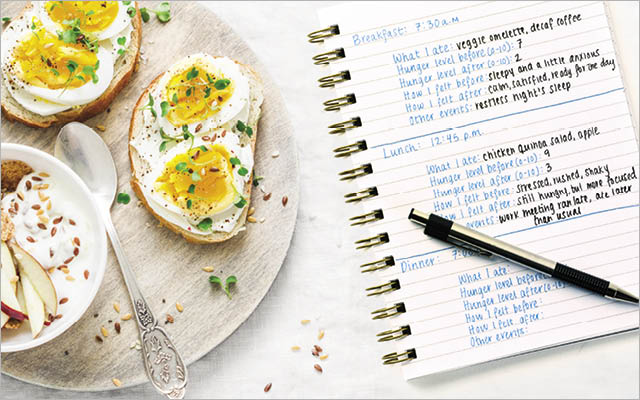You can’t remember what you ate for breakfast yesterday, but you can remember you ate it over your keyboard while responding to an email. You’ve been wondering if you need to eat more protein, but that trainer you follow on Instagram recently went keto, so maybe you should try that instead. You ate a healthy dinner in front of the TV just an hour ago, but now you’re rifling through the pantry for a snack.
Does this kind of chaotic food life sound familiar? You might consider food journaling.
A journal can be a useful tool for improving your relationship with food, whatever your health goals. If you’re looking to lose weight, for instance, it can improve outcomes: One study from Kaiser Permanente found that keeping a food journal helped participants double their results.
But it can do much more than that: The very act of recording your meals can help you make more intentional decisions about what and how you eat.
Heidi Schauster, MS, RDN, CEDRD-S, author of Nourish: How to Heal Your Relationship With Food, Body, and Self, believes that eating is really an act of self-care. “Journaling can bring your consciousness more fully to that experience,” she says. “It can actually help you listen to yourself.”
When you note what’s going on in your mind and body as well as what’s on your plate, you can begin to identify the patterns that shape your lifestyle. That can empower you to notice what doesn’t feel healthy, so you can cultivate habits that will serve your needs.
“The best way to get to know your body and what works for you is to give yourself some space to explore,” says nutrition coach Angelle Batten, cofounder of the Nourish to Flourish Society, a Michigan-based coaching firm. “Journaling can be a really effective way to do that.”
This practice is about building awareness, not necessarily recording every little bite. “Use your journal to support yourself to make choices that are more aligned with how you want to feel,” Batten advises. “It can teach you to trust yourself to give your body what you know it needs.”
Keep in mind, however, that this journaling method may not be helpful if you have a history of disordered eating; working with a professional nutritionist can help you establish habits that are right for you.
But if you’re simply interested in building more awareness of your daily eating choices, consider these food-journaling strategies.
Go analog. There are tons of apps to help you track your eating habits, but Schauster and Batten both prefer pen and paper. It may take more time, but slower usually means more mindful. A notebook also offers space to jot down mealtime thoughts and feelings.
Creating a personal template can help you stay focused on internal conditions such as your hunger and stress levels, as opposed to the external data — like calorie counts and portion sizes — that tend to drive many of our food choices.
“A lot of apps are designed to motivate you to eat fewer calories,” Schauster says. “They’re just another version of a diet. And what we know from the research is that dieting doesn’t work.”
Be in your body. Notice cues like dizziness, bloating, headaches, or constipation, any of which could indicate that your food choices aren’t aligning with your needs.
“Journaling can help you see patterns and learn more about what you truly require at certain times,” Batten explains. “That knowledge can allow you to cocreate your relationship with food.”
This kind of embodied attention can be challenging at first. “Our fast-paced culture really encourages us to be out of our bodies,” Schauster says. For instance, it’s common to ignore hunger until you’re famished — so you overeat as a result. But you can preempt that cycle by bringing attention to your body’s signals.
When her clients learn to connect to their feelings of hunger and satiety, Schauster has found, a lot of their confusion about what to eat vanishes. “That anxiety really dissipates when you’re eating in a more embodied way,” she explains, “because you’ve become the expert on what your body needs.”
Get emotional. Pay attention to what you feel around mealtime and notice if those feelings are influencing your behavior. If you notice a pattern of cravings arising with certain emotions (you want chocolate when you feel tense, for example), record it. There’s nothing wrong with making an emotional food choice, but staying aware will give you the opportunity to decide whether it’s the best option.
“I don’t like the term ‘emotional eating’ — it has this negative, shameful connotation,” Schauster admits. “In actuality, we all eat emotionally. Eating is an emotional experience.”
With that in mind, try to recognize how you feel when you’ve let your emotions dictate what you eat. Maybe reaching for chocolate when you have a stressful project at work doesn’t make you feel great. Take note, and let that knowledge inform your next choice.
Staying grounded in your emotions also means savoring what you eat. Food can be both nourishing and pleasurable, Batten says. You just need to welcome those feelings.
“There’s great science suggesting that when we enjoy what we’re eating, we digest and assimilate the nutrients more effectively,” she explains. “Give yourself permission to feel more pleasure — not just at the dinner table, but in all areas of your life.”
Do everything in moderation. According to both Schauster and Batten, this adage even applies to your journal: It’s meant to be a temporary practice, not a permanent habit. Batten thinks of the journal as a scaffolding, which her clients can eventually leave behind once they’ve taken some time to observe their eating behaviors.
Schauster encourages her clients to approach their journals with curiosity, not criticism. “There is no right way to eat,” she says. “There are only choices. Take notice, without judgment, of how those choices make you feel.”
“Everything in moderation” also means there are no good or bad foods, so there’s no need to feel guilt or shame if you “indulge.” This moderate approach will allow more latitude in your eating habits.
“Life happens. I sometimes check my email when I’m eating lunch,” Schauster says. “But typically, when I do that, I notice something missing from my experience. When I take the time to really taste my meal, I’m more satisfied and less likely to hunt for a snack an hour later. Food nourishes us on many levels if we pay attention.”
Take it slow. If your food journal uncovers behavior patterns you want to shift, start by making minor adjustments to support your long-term wellness. Healthy eating is different for everyone, and your own needs are likely to evolve over time.
Batten has found that gradually changing behavior has helped many of her clients realize that healthy eating doesn’t need to be terribly complicated — which means they don’t need to transform their habits overnight.
“Part of the problem is cultural,” she explains. “We’re in such a rush, so people assume they don’t have time to eat well. I always ask, ‘Can you find 10 minutes?’ Just take 10 minutes to mindfully eat a meal and notice how you feel. That’s a good place to start.”




This Post Has 0 Comments